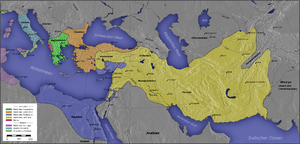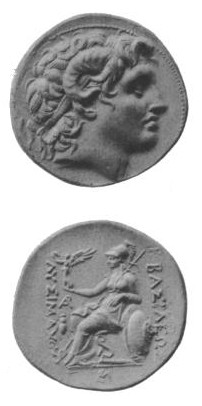Lysimachus: Difference between revisions
Torahjerus14 (talk | contribs) No edit summary |
|||
| Line 40: | Line 40: | ||
[http://books.google.com/books?id=JJ4K1wFZkrsC&pg=PA153&dq=Agathocles+Crannon++Lysimachus&sig=X0_Z_QlIA2mAuqAppc86fvZrB6M]</ref> Agathocles from [[Crannon]], Lysimachus was born in [[360 BCE]] in [[Pella|Pella,]] Macedon. During Alexander's [[Persian Empire|Persia]]n campaigns he was one of his immediate bodyguard and distinguished himself in [[India]]. After Alexander’s death ([[323 BCE]]) he was appointed to the government of Thrace and the [[Chersonese]]. For a long time he was chiefly occupied with fighting against the [[Odrysia]]n king [[Seuthes III]]. |
[http://books.google.com/books?id=JJ4K1wFZkrsC&pg=PA153&dq=Agathocles+Crannon++Lysimachus&sig=X0_Z_QlIA2mAuqAppc86fvZrB6M]</ref> Agathocles from [[Crannon]], Lysimachus was born in [[360 BCE]] in [[Pella|Pella,]] Macedon. During Alexander's [[Persian Empire|Persia]]n campaigns he was one of his immediate bodyguard and distinguished himself in [[India]]. After Alexander’s death ([[323 BCE]]) he was appointed to the government of Thrace and the [[Chersonese]]. For a long time he was chiefly occupied with fighting against the [[Odrysia]]n king [[Seuthes III]]. |
||
In [[315 BCE]] he joined [[Cassander]], [[Ptolemy I of Egypt|Ptolemy]] and [[Seleucus I Nicator|Seleucus]] against [[Antigonus I Monophthalmus|Antigonus]], who, however, diverted his attention by stirring up Thracian and [[Scythia]]n tribes against him. In [[309 BCE]], he founded [[Lysimachia (Thrace)|Lysimachia]] in a commanding situation on the neck connecting the Chersonese with the mainland. He followed the example of Antigonus in taking the title of king. In [[302 BCE|302]] when the second ''affiance'' between Cassander, Ptolemy and Seleucus was made, Lysimachus, reinforced by troops from Cassander, entered Asia Minor, where he met with little resistance. On the approach of Antigonus he retired into winter quarters near [[Heraclea Pontica|Heraclea]], marrying its widowed queen [[Amastris]], a Persian princess. Seleucus joined him in [[301 BCE]], and at the [[battle of Ipsus]] Antigonus was defeated and slain. His dominions were divided among the victors. Lysimachus share was [[Lydia]], [[Ionia]], [[Phrygia]] and the north coast of Asia Minor.<ref>Historians History of the World vol 4 p450</ref> |
In [[315 BCE]] he joined [[Cassander]], [[Ptolemy I of Egypt|Ptolemy]] and [[Seleucus I Nicator|Seleucus]] against [[Antigonus I Monophthalmus|Antigonus]], who, however, diverted his attention by stirring up Thracian and [[Scythia]]n tribes against him. In [[309 BCE]], he founded [[Lysimachia (Thrace)|Lysimachia]] in a commanding situation on the neck connecting the Chersonese with the mainland. He followed the example of Antigonus in taking the title of king. In [[302 BCE|302]] when the second ''affiance'' between Cassander, Ptolemy and Seleucus was made, Lysimachus, reinforced by troops from Cassander, entered Asia Minor, where he met with little resistance. On the approach of Antigonus he retired into winter quarters near [[Heraclea Pontica|Heraclea]], marrying its widowed queen [[Amastris]], a Persian princess. Seleucus joined him in [[301 BCE]], and at the [[battle of Ipsus]] Antigonus was defeated and slain. His dominions were divided among the victors. Lysimachus share was [[Lydia]], [[Ionia]], [[Phrygia]] and the north coast of [[Asia]] Minor.<ref>Historians History of the World vol 4 p450</ref> |
||
[[Image:Diadochen1.png|thumb|right|float|300px| |
[[Image:Diadochen1.png|thumb|right|float|300px| |
||
Revision as of 05:25, 17 February 2008
| Lysimachus | |
|---|---|
| King of Thrace King of Asia Minor King of Macedon | |
 Lysimachus as horned Alexander. | |
| Reign | 306–281 BCE |
Lysimachus (Greek: Λυσίμαχος, Lysimachos; 360 BCE - 281 BCE) was a Macedonian officer and diadochus (i.e. "successor") of Alexander the Great, who became a basileus ("king") in 306 BCE, ruling Thrace, Asia Minor and Macedonia.
Son of the Thessalian[1] Agathocles from Crannon, Lysimachus was born in 360 BCE in Pella, Macedon. During Alexander's Persian campaigns he was one of his immediate bodyguard and distinguished himself in India. After Alexander’s death (323 BCE) he was appointed to the government of Thrace and the Chersonese. For a long time he was chiefly occupied with fighting against the Odrysian king Seuthes III.
In 315 BCE he joined Cassander, Ptolemy and Seleucus against Antigonus, who, however, diverted his attention by stirring up Thracian and Scythian tribes against him. In 309 BCE, he founded Lysimachia in a commanding situation on the neck connecting the Chersonese with the mainland. He followed the example of Antigonus in taking the title of king. In 302 when the second affiance between Cassander, Ptolemy and Seleucus was made, Lysimachus, reinforced by troops from Cassander, entered Asia Minor, where he met with little resistance. On the approach of Antigonus he retired into winter quarters near Heraclea, marrying its widowed queen Amastris, a Persian princess. Seleucus joined him in 301 BCE, and at the battle of Ipsus Antigonus was defeated and slain. His dominions were divided among the victors. Lysimachus share was Lydia, Ionia, Phrygia and the north coast of Asia Minor.[2]

Feeling that Seleucus was becoming dangerously great, Lysimachus now allied himself with Ptolemy, marrying his daughter Arsinoe II of Egypt. Amastris, who had divorced herself from him, returned to Heraclea. When Antigonus’s son Demetrius I of Macedon renewed hostilities (297 BCE), during his absence in Greece, Lysimachus seized his towns in Asia Minor, but in 294 BCE concluded a peace whereby Demetrius was recognized as ruler of Macedonia. He tried to carry his power beyond the Danube, but was defeated and taken prisoner by the Getae king Dromichaetes (Dromihete), who, however, set him free on amicable terms. Demetrius subsequently threatened Thrace, but had to retire due to a sudden uprising in Boeotia, and an attack from the king Pyrrhus of Epirus.

In 288 BCE Lysimachus and Pyrrhus in turn invaded Macedonia, and drove Demetrius out of the country. Lysimachus left Pyrrhus in possession of Macedonia with the title of king for around seven months before Lysimachus invaded. For a short while the two ruled jointly but in 285 BCE Lysimachus expelled Pyrrhus.[3]
Domestic troubles embittered the last years of Lysimachus’s life. Amastris had been murdered by her two sons; Lysimachus treacherously put them to death. On his return Arsinoe asked the gift of Heraclea, and he granted her request, though he had promised to free the city. In 284 BCE Arsinoe, desirous of gaining the succession for her sons in preference to Agathocles (the eldest son of Lysimachus), intrigued against him with the help of her brother Ptolemy Keraunos; they accused him of conspiring with Seleucus to seize the throne, and he was put to death.
This atrocious deed of Lysimachus aroused great indignation. Many of the cities of Asia revolted, and his most trusted friends deserted him. The widow of Agathocles fled to Seleucus, who at once invaded the territory of Lysimachus in Asia. In 281 BCE, Lysimachus crossed the Hellespont into Lydia, and at the decisive Battle of Corupedium was killed. After some days his body was found on the field, protected from birds of prey by his faithful dog[4]. Lysimachus's body was given over to his son Alexander, by whom it was interred at Lysimachia.
References
- Arrian, Anabasis v. 13, vi. 28
- Justin xv. 3, 4, xvii. I
- Quintus Curtius V. 3, x. 30
- Diodorus Siculus xviii. 3
- Polybius v. 67
- Plutarch, Demetrius, 31. 52, Pyrrhus, 12
- Appian, Syriaca, 62
- Connop Thirlwall, History of Greece, vol. viii. (1847)
- J. P. Mahaffy, Story of Alexander’s Empire
- Droysen, Hellenismus (2nd ed., 1877)
- Adolf Holm, Griechische Geschichte, vol. iv. (1894)
- Benediktus Niese, Geschichte der griechischen und makedonischen Staaten, vols. i. and ii. (1893, 1899)
- Karl Julius Beloch, Griechische Geschichte vol. iii. (1904)
- Hunerwadel, Forschungen zur Gesch. des Könige Lysimachus (1900)
- Possenti, Il Re Lisimaco di Tracia (1901)
- Ghione, "Note sul regno di Lisimaco" (Atti d. real. Accad. di Torino, xxxix.)
- This article incorporates text from a publication now in the public domain: Chisholm, Hugh, ed. (1911). Encyclopædia Britannica (11th ed.). Cambridge University Press.
{{cite encyclopedia}}: Missing or empty|title=(help)
See also
- Lysimachus
- Lysimachus' Dog & Nisaean Horses - Informative but non-scholarly essay on Lysimachus (Annotated with Souces).

